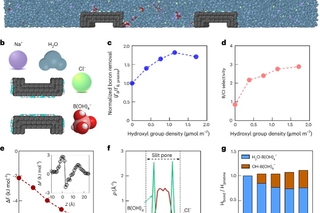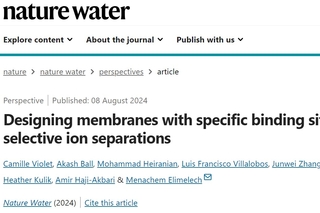
Schematic representation of the model filtration system with the membrane, two pistons, water molecules and Na+ and Cl- ions.
Procuring widespread access to a clean, stable water supply is an elusive, yet paramount goal which will continue to play an increasingly important role in global development, health, and well-being. Water scarcity already affects billions of people. Ongoing trends such as a rising population and climate change will further exacerbate this issue, making the development of water-treatment infrastructure one of the key areas of focus for the coming decades. Alongside strategies to properly manage water usage, new technologies can allow for better water reuse and reclamation, as well as the ability to tap into previously untreatable sources such as brackish water and seawater.
Among these new technologies, reverse osmosis desalination has emerged as a key technique for making use of the world’s abundant supply of salt water. It is already employed in numerous plants across the globe. The central element of these reverse osmosis desalination systems is a semipermeable membrane which readily allows for the passage of water while rejecting the flow of solutes such as dissolved salts. An applied pressure gradient across a saltwater feed adjacent to the membrane will generate a stream of fresh water flowing through the membrane. While reverse osmosis desalination is already being deployed with excellent effects, further advancements in membrane technology can improve this process, making it feasible and cost-effective in more areas.
Our group uses molecular simulations to generate a better fundamental understanding of the mechanisms of solvent and solute passage through semipermeable membranes with the intention of informing the design of the next generation of reverse osmosis desalination membranes. We develop the computational techniques needed to study these systems and use those tools to accurately and efficiently examine a range of potential desalination membranes including nanoporous graphene, polyamides, and MOFs. Our main focus is to understand how a membrane’s molecular structure impacts its selectivity for different types of solutes.These simulations are advancing the broader understanding of how semipermeable membranes function and how they can be improved.
Related Work
-
42. Secondary Finite-Size Effects and Multibarrier Free Energy Landscapes in Molecular Simulations of Hindered Ion Transport
Khalifa O., Shoemaker B., Haji-Akbari, A. J. Phys. Chem. B (2025)
-
40. A highly selective and energy efficient approach to boron removal overcomes the Achilles heel of seawater desalination
W. Pan, D. Roy, B. Uralcan, S. K. Patel, A. Iddya, E. Ahn, A. Haji-Akbari, J. Kamcev & M. Elimelech. Nature Water (2025) 3, p. 99–109
-
39. Designing membranes with specific binding sites for selective ion separations
C. Violet, A. Ball, M. Heiranian, L. F. Villalobos, J. Zhang, B. Uralcan, H. Kulik, A. Haji-Akbari & M. Elimelech.


